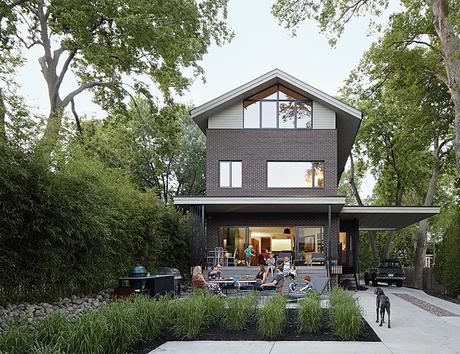
Matthew Hufft designed the house that he shares with his wife, Jesse, and their three children to sit inconspicuously among its neighbors in the Roanoke Park area of Kansas City, Missouri. The backyard and porch, which is furnished with a Saarinen Round Dining Table and Emeco Navy chairs, is a popular setting for warm-weather entertaining.
Project Showhouse Architect Hufft ProjectsIn Roanoke Park, a neighborhood in Kansas City, Missouri, whose streets are lined with sycamore trees and turn-of-the-20th-century Prairie School–style houses, Matthew and Jesse Hufft’s home stands out without subverting. Subtle gestures and forms—a roof that appears to float atop a glass gable, an effortlessly cantilevered 12-foot steel porte cochere—slowly reveal this house to be unlike its neighbors.
“I designed it so if you’re driving 30 miles per hour down the street, you don’t notice that it’s new,” says Matthew, an architect. “It fits into the neighborhood, an ode to the modern using technology and steel.”
Hufft conceived the house first and foremost as a home for himself and Jesse; their children, Rock, six, Cash, four, and Clover, two; and their dogs, Coltrane and Blue. But the dwelling also serves as a living showcase for the creative capabilities of Hufft Projects, the design-build firm Hufft founded in New York City in 2005 and later moved to Kansas City.
The custom-milled Silhouette table in the dining room—produced by the Edwin Blue line, which Hufft started with Clayton Vogel, an industrial designer, in 2010—is just one of many happy marriages of wood and blackened steel warming the interior. On the third floor, a burnt-cedar balcony extends from the office beneath a deep gabled overhang, offering an expansive view of the backyard. Off the living room, glass doors slide open onto a massaranduba hardwood deck with steps leading to a custom steel fire pit and a bamboo-sheltered patio.
“Three things have changed me as an architect,” Hufft says. “The first was building my parents’ house. The second was building our own house, and the third was having kids. It changes perspective in so many ways. We designed 20 homes before this, but I’m a different architect now. I understand the little things. This is a home that will change with us.”
Hufft came upon an empty lot in Roanoke Park in early 2011, discovered it was distressed and could be had for a steal, and quickly seized the opportunity, despite the plot’s 50-foot width. Through a series of space-dividing solutions, the home makes intelligent use of its limited footprint.
To enter the house from the front porch is to be immediately surrounded by examples of the custom craftwork that Hufft and his team produce nearby in a 60,000-square-foot converted warehouse, and to see how the different parts and disciplines fit together like a hidden joint. An elegant screen, made from powder-coated aluminum and white oak, is tucked directly behind the entrance—a vertical plane that contrasts with the horizontal surface of the Silhouette dining table. A bar and a powder room, the latter decorated with textured newsprint and reclaimed wood from a snow fence in Wyoming, provide a visual transition from the front of the house to the kitchen, where an elongated counter stretches across the room. The living room, a cozy space accented with blackened steel, opens to the back deck and patio.
“We knew we wanted a casual lifestyle and a house that flowed from the inside to the outside,” Hufft says. “We’re located near a busy intersection, so it was important to have that divider.”
Adaptable, human-centered design takes center stage on the second floor, where the playroom and children’s bedrooms were designed to grow with their occupants. Ornamented with special touches, such as CNC-cut details from Thomas Hart Benton murals on the ceiling, custom casework, and a flock of wooden butterflies, the rooms are playful but convertible. (The playroom, for example, will eventually become a workspace.) Downstairs, in the utilitarian mudroom, wooden cubbies make shoes, boots, mittens, and hats accessible to the children, while pop-open cabinets house bandages, a toolbox, and other essentials.
The third floor—encompassing the master bedroom and bathroom and a closet, all set under skylights, as well as an office and deck facing the street —serves as a refuge for the couple and features more distinctive touches. The bathroom fixtures—including vanities outfitted with circular mirrors embedded with fluorescent lights, and a wood-rimmed aluminum tub—lend an airy, open feel to the space. A custom cantilevered steel shelving unit that snaps together was an innovation born of efforts by the architects and fabricators to save time during construction.
One of the more striking touches is the artwork above the staircase, a framed drop cloth that from a distance resembles a Jackson Pollock painting. When Hufft’s father was growing up, he would help his own father paint, and the drop cloth became an important family memento and story. Hufft held on to it, eventually dividing it into sections and framing pieces for himself, his sister, and his father.
It’s a design choice that, like much of the artwork hanging in Hufft’s home and the principles at play in his custom creations, is informed by a deep layer of personal experience. In the backyard, a sculpture spells out “TIME,” in bold capital letters made from cedar planks. It serves as a daily reminder of the importance of reflection—and that history is often where one finds the best inspiration.
- Log in or register to post comments
